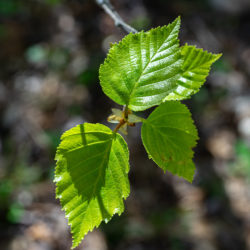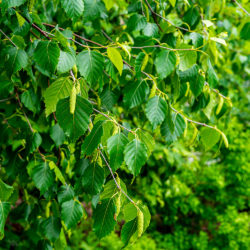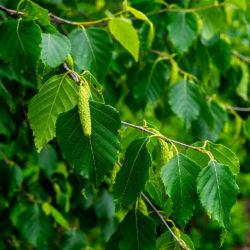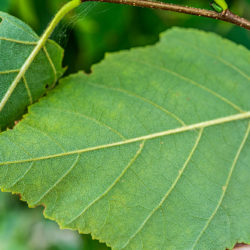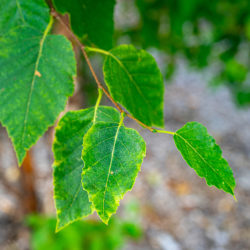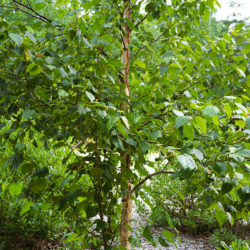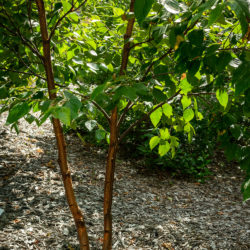Etymology
Betula is Latin for tree whose bark is used for writing upon; papyrifera is Greek for paper.
Native Habitat
Well-drained sandy loams and cool, moist settings of sun to part-shade.
Garden Uses
The mature white bark provides a lovely contrast in the garden, especially against full year dark backgrounds, such as evergreens. Useful as specimen or grove plantings. Prune for shaping only after sap has stopped flowing in the summer.
Overview
Long praised for its beautiful and practically useful peeling, silver bark, this tall (50 to 75 feet), short-lived birch is often multi-trunked, and is a predominant species on northern lake shores. It prefers summer temperatures below 70 degrees F. The young crown is pyramidal, becoming open and irregularly rounded at maturity, with slightly drooping, highly flexible branches.
Leaves and Stems
Leaves emerge after catkins, and are simple, alternate, wedge-shaped, up to 5 inches long, 2-4 inches wide, and double toothed. Leaves are smooth surfaced, dark green, changing to yellow in autumn. Outer bark is brown to golden brown, with visible lenticels in young trees, maturing to smooth, thin and white with black markings on main trunks and branches after 10 to 12 years. Inner bark is pink to orangey-brown. The white outer bark exfoliates or peels off easily, and often is seen hanging in loose pieces.
Flowers
Showy yellow or green catkins emerge before leaves. Both male and female catkins are on the same tree (monoecious). Male catkins are in groups of 1 to 3, erect over winter, and drooping at the tips of 1-year old twigs in the spring, hanging up to 4 inches long. Female catkins are solitary, erect, cylindrical, wider, and shorter (3/4 to 1-1/2 inches long), and grow from new, spur-like lateral twigs on the same branches as the males.
Fruit/Seed
Female catkins become oval, cone-like clusters about one inch long, composed of winged nutlets, each around 1/8 inch long, which dry from green to tan or brown.
Animal Associates
This birch species is also host to many insect larvae and pollinators (e.g. luna moth, Actias luna), both beneficial and destructive (paper birch is very susceptible to bronze birch borer, especially in unfavorable, dry growing conditions). Seeds are important food for birds and small mammals. Beaver and snowshoe hares feed on saplings.
Propagation
Seed can be sown in autumn in moist, sandy soil for spring germination; collect catkins directly into a bag, while they are still green enough to hold together.
Ethnobotanical Uses
Sheets of the bark and the flexible wood have traditionally been used for a variety of purposes by people of many cultures, including as a writing surface, and for making frames and containers, including snow shoes and canoes.
Garden Location
Performance Hall Garden, Residential Garden, Teaching Garden, West Woods, South Woods, North Woods (see garden map)
Sources
Lady Bird Johnson Wildflower Center
Yale University, Nature Walk: Paper birch
Plant Profile by Kate O'Dell

